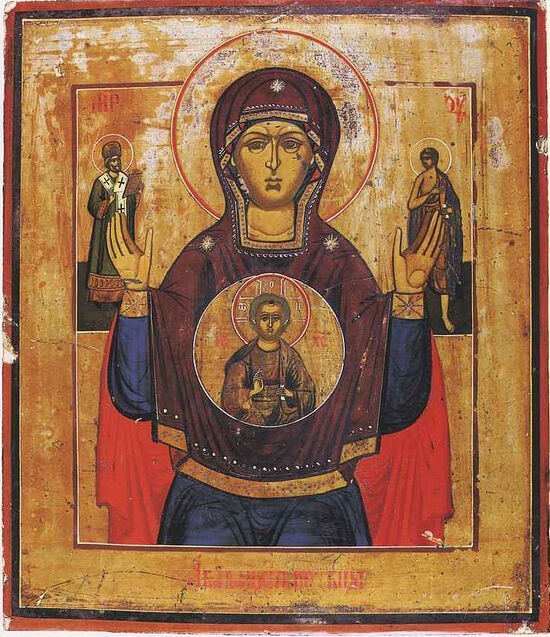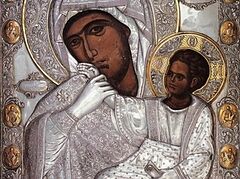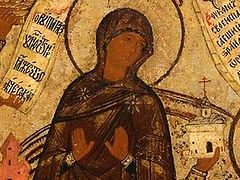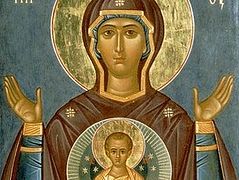This miraculous icon, the Abalatskaya Icon, is named after the Siberian village of Abalak in the Diocese of Tobolsk, a village in which a monastery was founded in 1783. During the reign of Tsar Mikhail Fyodorovitch, and during the episcopacy of Archbishop Nektary of Tobolsk, a widow named Maria lived alone in the Abalak country churchyard. In 1636, fifty years after Tobolsk was established, that widow, lightly dozing in her shack, had a vision in which she saw the Image of the Most-holy Theotokos of the Sign suspended in the air; depicted on the right was Holy Hierarch St. Nicholas the Wonder-worker, and on the left, the Venerable St. Mary of Egypt. She heard a voice order her to announce this vision to the people, and to tell them that they should build a new church, dedicated to the Sign Icon of the Most-holy Theotokos, to the right of the old Church of the Holy Transfiguration in the Alabak churchyard. The new church, dedicated to the Sign Icon that is in ancient Novgorod, was to have two side chapels—one to St. Nicholas, and the other, to St. Mary of Egypt. Maria awoke, but was too timid to dare tell anyone about the vision. The vision was repeated four times.
The fourth vision was quite a significant one, and Maria could no longer keep it secret. She was on her way from Abalak to Tobolsk, when, going up the hill toward the town, she suddenly stopped as if in a fog. Before her there appeared something like a pillar of clouds, and on the pillar was the image of the Sign of the Mother of God and the image of St. Mary of Egypt. St. Nicholas, as if alive, was standing on the ground, and angrily said to her, “Why are you slow to announce your visions and to relate the commands to the people?” After that, the widow began to tell every one of her visions and she related them to Archbishop Nektary before everyone in the Cathedral. Everyone believed the pious widow’s accounts. After submitting her to an exhaustive inquiry, the Archbishop blessed the residents of Abalak to construct the church; many of the residents of Tobolsk participated in that work. By God’s providence, a patronal icon was prepared for that church.
For many years, a certain peasant named Euphemy had lain paralyzed. It happened that a certain Paul, an indigent who received support from Euphemy, came by and said to him, “Euphemy! A church is being built at God’s direction in Abalak; it is dedicated to the Sign Icon of the Theotokos, to St. Nicholas, and to St. Mary of Egypt. Make a vow to have a patronal icon painted for that church. Perhaps, in return for your faith and diligence, the Lord will forgive you and will free your from your illness.” Euphemy heeded him as if he were the Angel of the Lord, and the same day vowed to prepare an icon of the Sign of the Mother of God, with St. Nicholas and St. Mary of Egypt at either side. The Lord heard his prayers, and in the afternoon of the same day, he regained the use of the right side of his body. The next day, Euphemy dispatched a request to His Eminence Nekary for permission to paint a patronal icon for the new church in Abalak. Upon receiving a hierarchical blessing, he ordered the painting of an icon by the then most accomplished artist in Siberia—Protodeacon Matthew of the Tobolsk Cathedral. All the time that the icon was being painted, Euphemy prayed; each day he became stronger. Finally, feeling himself restored to health, he himself went to the artist and with his own hands brought the icon to the Cathedral to be blessed.
Several copies of the Abalatskaya icon exist in various places in Siberia. They are revered by the local populace, and at certain times are carried in procession to surrounding towns and settlements.
Parish Life, August 2020
Russian Orthodox Cathedral of St. John the Baptist Washington, DC





